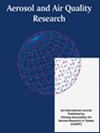Impacts of Floods on the Indoor Air Microbial Burden
IF 2.5
4区 环境科学与生态学
Q3 ENVIRONMENTAL SCIENCES
引用次数: 0
Abstract
Floods create a conducive environment for the proliferation of microbes in the indoor air by providing nutrients and moisture and by introducing new microbes from outdoors to indoors. Thus, it is important to better understand the level of proliferation and the characteristics of microbes in the indoor air of flooded built environments. In this work, we address these aspects in a flooded environment in India and investigate the changes in the indoor air microbial burden by comparing with the control (non-flooded) houses. Flooded houses within one month of water recession were compared with control houses. Microbes (bacteria, fungi) were characterized and endotoxins were quantified. Microbial concentrations were significantly higher in flooded houses than the control houses ( p < 0.05). The potential infectious bacterial genera Pantoea , Acinetobacter , and fungal genera Aspergillus and Penicillium were found dominant in the indoor air of flooded houses. Though these fungal genera were also present in the control houses, concentrations were higher ( p < 0.05) in the flooded houses. Multivariable regression analysis revealed that indoor air microbial burden was significantly and positively associated with outdoor air and outdoor soil. Further, antibiotic resistant bacteria (ARB) were found in both indoor air, and outdoor water sources (wells) of flooded houses. In our chlorine tests, the bacteria showed resistance to concentrations above 100 ppm, far exceeding those found in national and international guidelines. Bacteria were resistant to common antibiotics such as penicillin and ciprofloxacin.洪水对室内空气微生物负荷的影响
本文章由计算机程序翻译,如有差异,请以英文原文为准。
求助全文
约1分钟内获得全文
求助全文
来源期刊

Aerosol and Air Quality Research
ENVIRONMENTAL SCIENCES-
CiteScore
8.30
自引率
10.00%
发文量
163
审稿时长
3 months
期刊介绍:
The international journal of Aerosol and Air Quality Research (AAQR) covers all aspects of aerosol science and technology, atmospheric science and air quality related issues. It encompasses a multi-disciplinary field, including:
- Aerosol, air quality, atmospheric chemistry and global change;
- Air toxics (hazardous air pollutants (HAPs), persistent organic pollutants (POPs)) - Sources, control, transport and fate, human exposure;
- Nanoparticle and nanotechnology;
- Sources, combustion, thermal decomposition, emission, properties, behavior, formation, transport, deposition, measurement and analysis;
- Effects on the environments;
- Air quality and human health;
- Bioaerosols;
- Indoor air quality;
- Energy and air pollution;
- Pollution control technologies;
- Invention and improvement of sampling instruments and technologies;
- Optical/radiative properties and remote sensing;
- Carbon dioxide emission, capture, storage and utilization; novel methods for the reduction of carbon dioxide emission;
- Other topics related to aerosol and air quality.
 求助内容:
求助内容: 应助结果提醒方式:
应助结果提醒方式:


